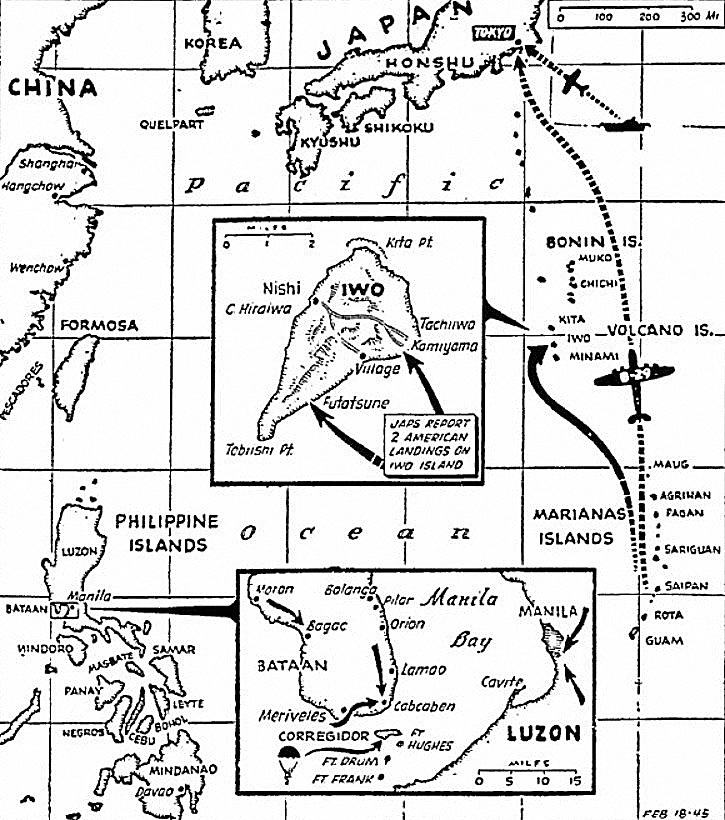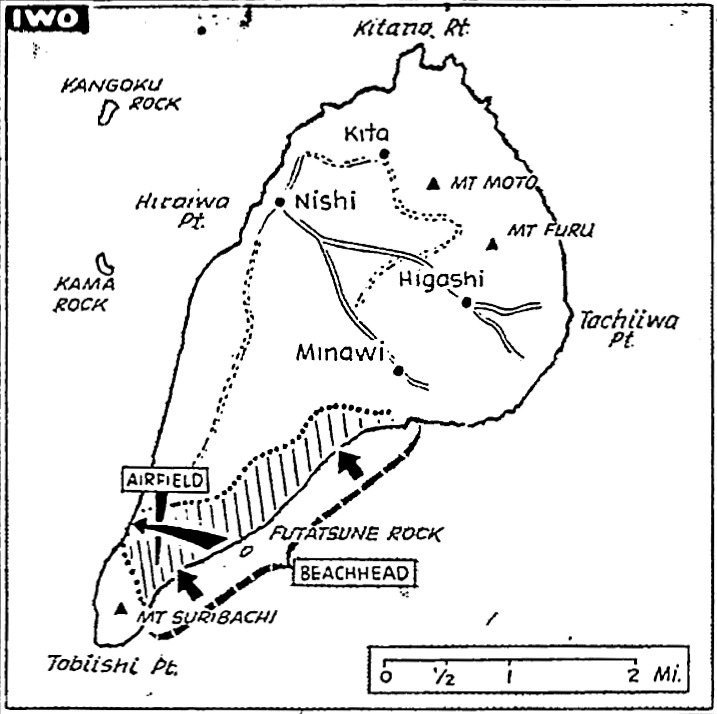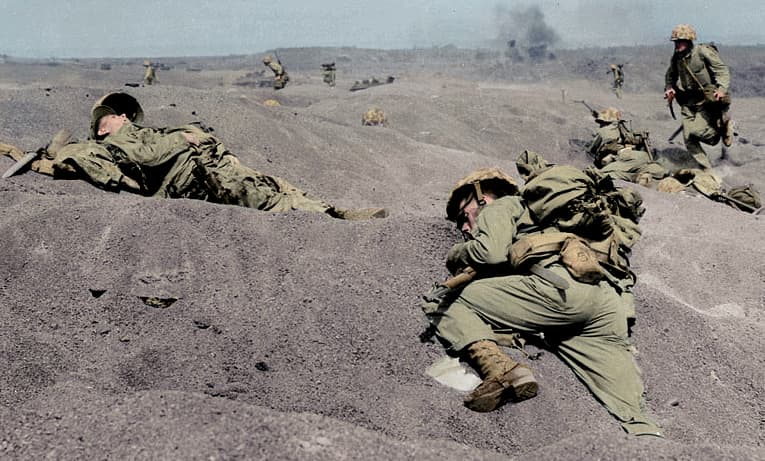The Pittsburgh Press (February 17, 1945)
LANDING REPORTED ON IWO
Burning Tokyo blasted again
Landing below Japan follows heavy U.S. air-sea bombardment
By William F. Tyree, United Press staff writer
New island hop by U.S. troops, this time landing on Iwo Island in the Volcanos, was reported by the Japs. To the north, U.S. carrier planes raided Tokyo for the second straight day.
ADM. NIMITZ’s HQ, Guam – U.S. troops stormed ashore early today on Iwo Island, only 750 miles south of Tokyo, enemy broadcasts reported.
At the same time, carrier planes hit the burning Jap capital for the second straight day of a diversionary assault.
Invasion forces swarmed over the southwest and southeast beaches of Iwo in twin landings only 10 minutes apart, a Tokyo Domei broadcast said. It added the customary claim that the troops had been “repulsed” after fierce fighting.
The report of the invasion came on the second day of an earth-shaking bombardment of Iwo in the Volcano Islands by more than 30 U.S. warships – ranging from battleships to destroyers – and scores of carrier- and land-based bombers. Most shore batteries were knocked out yesterday.
The U.S. Navy Department declined to comment on the Jap reports of the Iwo landings. One official pointed out that the enemy often makes such claims in an effort to “fish for information.”
Japs claim 147 planes downed
A landing on Iwo would represent an amphibious jump of 750 miles – halfway to Tokyo – from the Marianas for the Americans and would give them at least three strategic air bases within Flying Fortress, Liberator and fighter-plane range of the enemy capital.
Wave after wave of U.S. carrier planes sent hundreds more tons of bombs crashing down on smoking Tokyo today. A Jap communiqué said the second day of the unprecedented assault got underway at 7 a.m. (6 p.m. Friday ET) and the raid was still continuing 8½ hours later.
The Japs said 200 U.S. carrier planes have been attacking Hachijo Island, in the Izu group 200 miles south of Tokyo, since early yesterday.
The enemy communiqué admitted that 61 Jap planes were lost in yesterday’s nine to 10-hour attack on Tokyo, but claimed 147 U.S. planes were shot down and more than 50 damaged. Jap planes counterattacking the American task force “heavily damaged and set afire” a large warship, believed an aircraft carrier, the communiqué said.
Battleship sunk, Tokyo claims
Tokyo broadcasts freely interpreted the assault as a diversionary attack to cover an invasion of Iwo and one said an American landing on Japan itself may be near. Another warned without elaboration that U.S. forces may “attempt to come near the homeland at two points, one of them the Boso Peninsula,” western arm of Tokyo Bay and site of the Yokosuka Naval Base.
Domei said U.S. forces began landing operations on Futatsune Beach in Southwest Iwo about 10:30 a.m. (9:30 p.m. Friday ET), but were “completely smashed.”
“Following the failure, all enemy troops withdrew far out to sea,” the broadcast said.
Two minutes later – 10:40 a.m. – U.S. troops began landing on Kamiyama Beach on the southeastern tip of the tiny eight-square-mile island, Domei said.
“Our garrison troops going into action to engage these enemy forces successfully repulsed them, with severe losses inflicted on the invaders,” it asserted.
The broadcast, while saying that the second landing had been “repulsed,” notably made no claim that these forces had also withdrawn.
Iwo, a gourd-shaped island in the Volcano group, is barren and rocky. The Japs, however, built three airfields on its shores from which to intercept Tokyo-bound Superfortresses and raid their bases in the Marianas. It also served as an observation post from which to warn the homeland of the approach of Superfortresses.
The landing, if confirmed, would put U.S. troops for the first time on Jap soil administered as part of the Tokyo Prefecture. Winter monsoons normally sweep the area from December to March, bringing strong winds and high seas.
A Jap communiqué claimed counterattacking Jap batteries and planes at Iwo sank a battleship, two cruisers and two other ships of the invasion fleet. Three assault craft were damaged and 10 American planes shot down, the communiqué said.
Three waves totaling 50 planes from the sky-filling fleet of 1,200 to 1,300 aboard the world’s biggest carrier armada standing less than 300 miles off the Jap coast opened today’s assault on the Tokyo area soon after dawn, enemy broadcasts said.
Other formations followed at intervals of an hour and a half, concentrating on Greater Tokyo itself rather than inland targets as yesterday, broadcasts said. They admitted transportation facilities in the Tokyo metropolitan district and adjacent areas had been hit.
A Jap communiqué issued at 3:30 p.m. (2:30 a.m. ET) acknowledged that the raids were still continuing at that hour.
The Tokyo radio said at 9:06 p.m. (8:06 a.m. ET) that the air-raid warning was continuing in the Tokyo-Yokohama area “because of an unknown object in the southern waters.” Fourteen minutes later Tokyo said one American plane was flying northward over the Izu Islands toward the capital.
It asserted that the American carrier planes had caused only “slight” damage to ground installations in yesterday’s attack on the Tokyo area. However, a pall of smoke, broken by occasional flashes of fire, still hung over Tokyo from that attack as the second phase of the assault got underway today.
Domei reported that 600 carrier planes took part in today’s raid on Tokyo, compared with 1,200 to 1,300 yesterday. The agency said the attacks were centered on airfields and aircraft factories in the Kanto area, which embraces the Tokyo-Yokohama metropolitan districts.
A Superfortress pilot who witnessed yesterday’s raids said as many as 1,200 planes were over the capital at one time, it was speculated that the planes flew more than 2,000 sorties yesterday.
Adm. Chester W. Nimitz, commander of the Pacific Fleet, confirmed that the assault on Tokyo had extended into a second day in a brief communiqué which said merely that the attack was “continuing.” Unofficial reports reaching headquarters indicated that the first day’s attackers met “considerable success.”
B-29s sight smoke
Superfortresses crew who witnessed the attack from the substratosphere told of smoke rising 7,000 feet or more from burning installations and of scores of Jap planes shot down or destroyed on the ground.
It was assumed that yesterday’s attacks were designed to destroy or pin down enemy planes on the several dozen fields dotting the great plain around Tokyo. Today, it was believed, Helldivers and Avengers began pinpoint bombing of Jap military installations, including aircraft repair and manufacture facilities.
Tokyo conceded that the assault appeared to have the aim of destroying the Jap Air Force.
Japs too busy
The fact that the Japs to date have mentioned only one attack on the task force off their coast may indicate that they have been so busy attempting to protect Tokyo that they have been unable to muster sufficient planes to attack the American carriers.
Adm. Nimitz said in his communiqué that preliminary reports indicated “considerable damage” had been inflicted on installations on Iwo by battleships and cruisers during the first day of the bombardment yesterday.
Silence batteries
Enemy shore batteries which sought to answer the bombardment were silenced, he said. Carrier aircraft set fire to two luggers and probably destroyed three enemy bombers on the ground.
A Kingfisher seaplane from one of the cruisers in the bombardment force shot down a Jap Zero fighter. One American aircraft was shot down by enemy anti-aircraft batteries, but the pilot was rescued.




